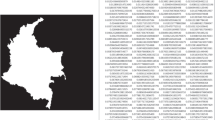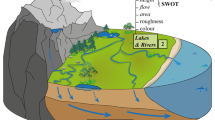Abstract
A new multi-sensor approach, named PoLCast (Probability of Lightning foreCast), for predicting the lightning activity in a complex orography geographical area is proposed and discussed. The PoLCast input information are the ground-based weather radar horizontally polarized reflectivity factor and the atmospheric instability indexes, derived from the Spin Enhanced Visible Infrared Imager (SEVIRI) radiometer onboard the Meteosat Second Generation (MSG) satellite. The weather radar data are used to calculate the probability of lightning following a direct relation between the maximum values of the reflectivity factor and the lightning occurrence, whereas the atmospheric instability indexes from SEVIRI are used to constrain the probability of lighting, derived from weather radar data, and enhance such probability in cases of more unstable troposphere. To test the PoLCast methodology, the output of the Blitzortung and the “Sistema Italiano Rilevamento Fulmini” (SIRF) ground-based lightning sensor networks are used together with the C-band Mt. Midia weather radar within its 180 km diameter coverage over the Central Italy area. Both satellite and radar data are pre-processed into PoLCast to obtain a single time series in terms of the areal probability of lightning (PoL). PoLCast performances are evaluated in terms of statistical scores using 12 heterogeneous case studies over Central Italy. Even though the number of available cases is relatively limited, quantitative results show high areal PoL (from 0 to 100%) with a case-by-case variability of false alarm rate from 3 to 72%. The advantage of a multi-sensor technique, such as PoLCast, with respect to an approach using weather radar data only, becomes more evident when lightning activity is not present and the leading time of lightning forecast exceeds 2.5 h.









Similar content being viewed by others
References
Adhikari A, Liu C (2019) Geographical distribution of thundersnow events and their properties from GPM Ku-band radar. Journal of Geophysical Research: Atmospheres 124:2031–2048. https://doi.org/10.1029/2018JD028839
American Meteorological Society (AMS) Glossary of Meteorology (2013). Available at: http://glossary.ametsoc.org/wiki/Main_Page. Accessed 3 April 2020
Bernardi M, Ferrari D (2000) The Italian lightning detection system (CESI-SIRF): main statistical results on the first five years of collected data and a first evaluation of the improved system behavior due to a major network upgrade. Proc. 25th International Conference on Lightning Protection, Rhodos (Grece), addendum in section 2
Buechler DE, Goodman SJ (1990) Echo size and asymmetry: impact on NEXRAD storm identification. J. Appl. Meteor. 29:962–969. https://doi.org/10.1175/1520-0450(1990)029<0962:ESAAIO>2.0.CO;2
Capozzi V, Montopoli M, Mazzarella V, Marra AC, Roberto N, Panegrossi G, Dietrich S, Budillon G (2018) Multi-variable classification approach for the detection of lightning activity using a low-cost and portable X band radar. Remote Sens 10:1797. https://doi.org/10.3390/rs10111797
Carey LD, Rutledge SA (1996) A multiparameter radar case study of the microphysical and kinematic evolution of a lightning producing storm. J Meteorol Atmos Phys 59:33–64. https://doi.org/10.1007/BF01032000
Carey LD, Rutledge SA (2000) The relationship between precipitation and lightning in tropical island convection: a C-band polarimetric radar study. AMS 128:2687–2710. https://doi.org/10.1175/1520-0493(2000)128<2687:TRBPAL>2.0.CO;2
Cimini D, Nelson M, Güldner J, Ware R (2015) Forecast indices from a ground-based microwave radiometer for operational meteorology. Atmos Meas Tech 8:315–333. https://doi.org/10.5194/amt-8-315-2015
Christian HJ, Blakeslee RJ, Goodman SJ, Mach DA, Stewart MF, Buechler DE, Koshak WJ, Hall JM, Boeck WL, Driscoll KT, Bocippio DJ (1999) The lightning imaging sensor. Proceedings of the 11th international conference on atmospheric electricity, 746-749, Guntersville, Alabama, June 7-11, 1999
Christian HJ, Blakeslee RJ, Boccippio DJ, Boeck WL, Buechler DE, Driscoll KT, Goodman SJ, Hall JM, Koshak WJ, Mach DM, Stewart MF (2003) Global frequency and distribution of lightning as observed from space by the optical transient detector. J of Geophys Res 108:4005–4020. https://doi.org/10.1029/2002JD002347
Clements NC, Orville RE (2008) The warning time for cloud-to-ground lightning in isolated, ordinary thunderstorms over Houston, Texas. 3rd Conf. On meteorological applications of lightning data, New Orleans, LA, Amer meteor Soc.
Conte D, Miglietta MM, Levizzani V (2011) Analysis of instability indices during the development of a Mediterranean tropical-like cyclone using MSG-SEVIRI products and the LAPS model. Atmos Res 101:264–279. https://doi.org/10.1016/j.atmosres.2011.02.016
De Coning E, Koenig M, Olivier J (2011) The combined instability index: a new very-short range convection forecasting technique for southern Africa. Meteorol Appl 8:421–439. https://doi.org/10.1002/met.234
Dietrich S, Casella D, Di Paola F, Formenton M, Mugnai A, Sanò P (2011) Lightning-based propagation of convective rain fields. Nat Hazards Earth Syst Sci 11:1571–1581. https://doi.org/10.5194/nhess-11-1571-2011
EUMETSAT (2010) Global instability index factsheet, EUM/OPS/DOC/09/5170, v1, 6 October 2010
Federico S, Avolio E, Petracca M, Panegrossi G, Sanò P, Casella D, Dietrich S, Kotroni V, Yair Y (2014) Simulating lightning into the RAMS model: implementation and preliminary results. Nat Hazards Earth Syst Sci 14:2933–2950. https://doi.org/10.5194/nhess-14-2933-2014
Fierro AO, Mansell ER, MacGorman DR, Ziegler CL (2013) The implementation of an explicit charging and discharge lightning scheme within the WRF-ARW model: benchmark simulations of a continental squall line, a tropical cyclone, and a winter storm. Mon Weather Rev 141:2390–2415
Goodman SJ, Buechler DE, Wright PD (1989) Polarization radar and electrical observations of microburst producing storms during COHMEX. In Proceedings of the AMS 24th Conference on Radar Meteorology, Tallahassee, FL, USA, 27–31 March 1989
Gremillion MS, Orville RE (1999) Thunderstorm characteristics of cloud-to-ground lightning at the Kennedy Space Center, Florida: a study of lightning initiation signatures as indicated by the WSR-88D. Wea Forecasting 14:640–649. https://doi.org/10.1175/1520-0434(1999)014<0640:TCOCTG>2.0.CO;2
Haklander AJ, Van Delden A (2003) Thunderstorm predictors and their forecast skill for the Netherlands. Atmo Res 67-68:273–299. https://doi.org/10.1016/S0169-8095(03)00056-5
Holle RL, López RE, Zimmermann C (1999) Updated recommendations for lightning safety −1998. AMS 80(10):2035–2041
König M (2002) Atmospheric instability parameters derived from MSG SEVIRI observations EUMETSAT Technical Memorandum No 9
Krawchuk MA, Cumming SG, Flannigan MD (2009) Predicted changes in fire weather suggest increases in lightning fire initiation and future area burned in the mixedwood boreal forest. Climate Change 92(1–2):83–97. https://doi.org/10.1007/s10584-008-9460-7
Kuettner JP, Levin Z, Sartor JD (1981) Thunderstorm electrification—inductive or non-inductive? J Atmos Sci 38:2470–2484. https://doi.org/10.1175/1520-0469(1981)038<2470:TEONI>2.0.CO;2
López RE, Aubagnac JP (1997) The lightning activity of a hailstorm as a function of changes in its microphysical characteristics inferred from polarimetric radar observations. J Geophys Res 102:16799–16813. https://doi.org/10.1029/97JD00645
Liu C, Cecil D, Zipser EJ (2011) Relationships between lightning flash rates and passive microwave brightness temperatures at 85 and 37 GHz over the tropics and subtropics. J Geophys Res 116:D23108. https://doi.org/10.1029/2011JD016463
MacGorman DR, Filiaggi T, Holle RL, Brown RA (2007) Negative cloud-to-ground lightning flash rates relative to VIL, maximum reflectivity, cell height, and cell isolation. J Lightning Res 1:132–147
Marzano FS, Picciotti E, Vulpiani G (2004) Rain field and reflectivity vertical profile reconstruction from C-band radar volumetric data. IEEE Trans Geosci Rem Sens 42(4):1033–1046. https://doi.org/10.1109/TGRS.2003.820313
Mosier RM, Schumacher C, Orville RE, Carey LD (2011) Radar nowcasting of cloud-to-ground lightning over Houston, Texas. AMS 26:199–212. https://doi.org/10.1175/2010WAF2222431.1
Mostajabi A, Finney DL, Rubinstein M, Rachidi F (2019) Nowcasting lightning occurrence from commonly available meteorological parameters using machine learning techniques npj. Clim Atmos Sci 2:41. https://doi.org/10.1038/s41612-019-0098-0
Nesbitt SW, Zipser EJ, Cecil DJ (2000) A census of precipitation features in the tropics using TRMM: radar, ice scattering, and lightning observations. J Clim 13:4087–4106. https://doi.org/10.1175/1520-0442(2000)013<4087:acopfi>2.0.co;2
Nierow A, Showalter RC (2000) An evaluation of using lightning data to improve aviation oceanic convective forecasting for the Gulf of Mexico. Digital Avionics Systems Conference, Proceedings. DASC. The 19th 1:D5/1-3D5/7
Paliaga G, Donadio C, Bernardi M, Faccini F (2019) High-resolution lightning detection and possible relationship with rainfall events over the Central Mediterranean Area. Remote Sens 11:1601. https://doi.org/10.3390/rs11131601
Peppier RA (1988) A review of static stability indices and related thermodynamic parameters. Illinois State Water Survey Division, SWS Miscellaneous Publication 104, available at: http://www.isws.illinois.edu/pubdoc/MP/ISWSMP-104.pdf (last access: 3 April 2020)
Peterson M, Liu C (2011) Global statistics of lightning in anvil and stratiform regions over the tropics and subtropics observed by the Tropical Rainfall Measuring Mission. J Geophys Res 116:D23201. https://doi.org/10.1029/2011JD015908
Preston AD, Fuelberg HE (2015) Improving lightning cessation guidance using polarimetric radar data. Weather Forecast 30:308–328. https://doi.org/10.1175/WAF-D-14-00031.1
Roberto N, Adirosi E, Baldini L, Casella D, Dietrich S, Gatlin P, Panegrossi G, Petracca M, Sanò P, Tokay A (2016) Multi-sensor analysis of convective activity in central Italy during the HyMeX SOP 1.1. Atmos Meas Tech 9:535–552. https://doi.org/10.5194/amt-9-535-2016
Rudlosky SD, Goodman SJ, Virts KS, Bruning EC (2019) Initial geostationary lightning mapper observations. Geophys Res Lett 46:1097–1104. https://doi.org/10.1029/2018GL081052
Silberstein D, Wolff D, Marks D, Atlas D, Pippit J (2008) Ground clutter as a monitor of radar stability at Kwajalein. RMI J Atmos Ocean Tech 25:2037–2045. https://doi.org/10.1175/2008JTECHA1063.1
Stagliano J (2010) Lightning threat nowcasting with polarimetric radar. AMS, 26th conference on interactive information and processing systems (IIPS) for meteorology, oceanography, and hydrology, Atlanta, GA, 17–21
Suszcynsky DM, Kirkland MW, Jacobson AR, Franz RC, Knox SO, Guillen JLL, Green JL (2000) FORTE observations of simultaneous VHF and optical emissions from lightning: basic phenomenology. J of Geophy Res Atmo 105(no.D2):2191–2201. https://doi.org/10.1029/1999JD900993
Toracinta ER, Zipser EJ (2001) Lightning and SSM/I-ice-scattering mesoscale convective systems in the global tropics. AMS 40:983–1002. https://doi.org/10.1175/1520-0450(2001)040<0983:LASIIS>2.0.CO;2
Vincent BR, Carey LD, Schneider D, Keeter K, Gonski R (2004) Using WSR-88D reflectivity for the prediction of cloud-to-ground lightning: a central North Carolina study. Natl Wea Dig 27:35–44
Wanke E (2011) Blitzortung.org—a low cost time of arrival lightning location network. blitzortung.org/Documents/TOA_Blitzortung.pdf. Accessed on 15 October 2019
Wiens KC, Rutledge SA, Tessendorf SA (2005) The 29 June 2000 supercell observed during STEPS. Part II: Lightning and charge structure J Atmos Sci 62:4151–4177. https://doi.org/10.1175/JAS3615.1
Wolf P (2007) Anticipating the initiation, cessation, and frequency of cloud-to-ground lightning, utilizing WSR-88D reflectivity data. NWA Electronic Journal of Operational Meteorology:2007–2EJ1
Acknowledgments
We are grateful to the High Innovation in Meteorology and Environmental Technologies (HIMET, L’Aquila, Italy) staff for their support in processing raw satellite and radar data and, in particular, to Mr. Livio Berardini for his availability in MSG data processing. The authors are grateful to the CFA, Functional Centre of Abruzzo Region Civil Protection (Italy), for providing radar data used in this work.
Author information
Authors and Affiliations
Corresponding author
Ethics declarations
Conflict of interest
The authors declare that they have no conflict of interest.
Appendix A: Atmospheric instability indexes
Appendix A: Atmospheric instability indexes
In this appendix, a brief summary of the instability indexes is given. The instability indexes considered in this work are the K-Index (KI), maximum buoyancy index (MB), and the lifted index (LI). They can be potentially used for the prediction of severe weather events, as they provide an indication of the potential convective triggering and development in clear air well in advance with respect to the time when the thunderstorm will occur. The main limitation of the instability products is that their computation cannot be performed in cloudy areas, as well explained in the EUMETSAT Global Instability Index Factsheet (Conte et al. 2011). They are usually distributed as Global Instability Index (GII) at a coarse horizontal resolution of about 60–70 km over the Mediterranean area every 15 min. Instead, regional instability index (RII), used in this paper, are distributed with a spatial resolution of 25 km over the area of central Italy every 5 min. Validation of instability indexes from satellite against independent measurement, such as sounding data, is performed at EUMETSAT (König 2002; De Coning et al. 2010), though a systematic study is not available to our knowledge.
LI depends on the temperature at the vertical level of 500 mb, which corresponds to 5.5 km in standard atmosphere conditions, compared with the temperature of an air parcel adiabatically lifted up. Lower values of LI likely correspond to higher probability of thunderstorms. Table 5 summarizes typical values of LI. KI is a function of temperature and humidity at pressure levels of 850, 700, and 500 mb. Larger values of KI usually predict thunderstorms. Table 6 describes KI typical values. MB index was developed to identify areas for potential instability. Larger values of MB indicate higher probability of thunderstorms, as indicated in Table 7.
Rights and permissions
About this article
Cite this article
Montopoli, M., Cimini, D., Picciotti, E. et al. Investigating ground-based radar and spaceborne infrared radiometer synergy for lightning areal prediction in complex orography. Bull. of Atmos. Sci.& Technol. 1, 231–256 (2020). https://doi.org/10.1007/s42865-020-00013-6
Received:
Accepted:
Published:
Issue Date:
DOI: https://doi.org/10.1007/s42865-020-00013-6




